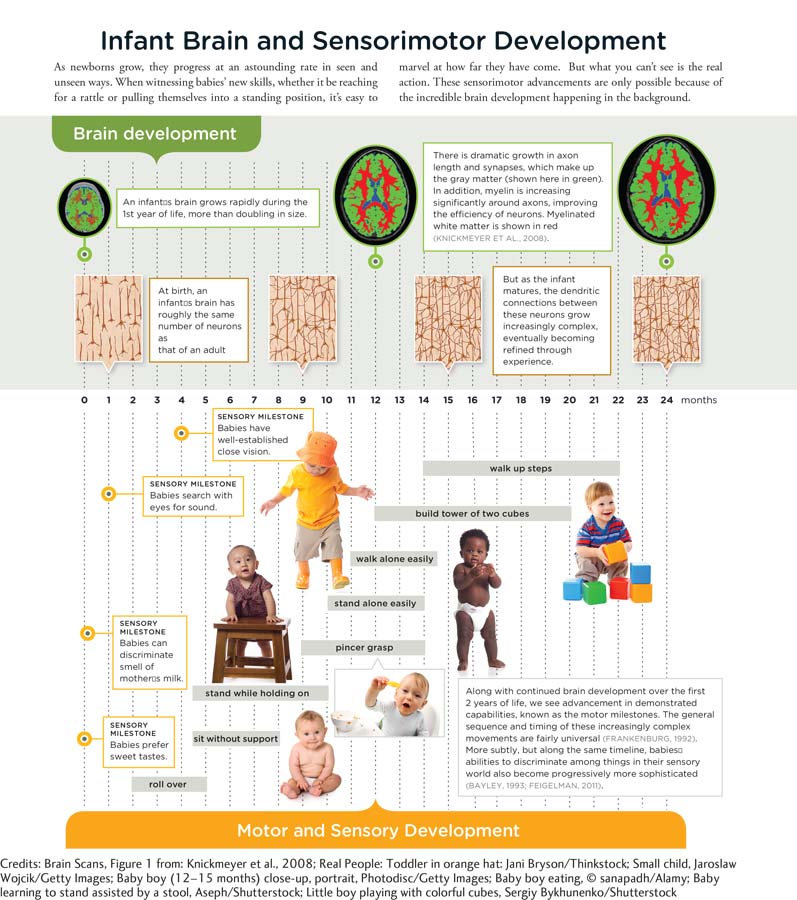Chapter 1. Chapter
Infographic
Scientific American: Psychology
Infographic Activity 8.2: Infant Brain and Sensorimotor Development
Infant Brain and Sensorimotor Development

As newborns grow, they progress at an astounding rate in seen and unseen ways. When witnessing babies’ new skills, whether it be reaching for a rattle or pulling themselves into a standing position, it’s easy to marvel at how far they have come. But what you can’t see is the real action. These sensorimotor advancements are only possible because of the incredible brain development happening in the background.
Click the image to enlarge.
Click "Next" to continue.
1.1 Quiz
Question
DJyd0qbuO5xZcu6bjEXrLiSVO3kWZg+X8vGeRWYI8f2UtV94duTVC248lER9cS0rMw1lsaj0ROZ3/IHAcCUKZppXavrc7NC/BuTj9Mja+7nk2cYtf63ugdPEEnmlxyZutK0fi4pOhgLdmwSBAKRq5QdrBUy93OwWzaAzoseKAzJ5TWjWfhYcP7Hztmj6J9XnqTn0ZSi3QR6v1s5XSkxpsOFFbxs7rX2hQrmfWo3+4yv5aoBdUfGKCHhsT0bMUnEtXzxvASlLxqMmDJRrhL5c3gloUT4l6d7k+CT/tZ/ntjHPc2o67DrqGVwydYcgh4BEUrqT5pbUvN8OXn7DhCX8WnqwSiMC5khHAEKZMIoVpPXsSwyCa2wsUg==Correct.
Incorrect.
Question
rHRkX03wGTKuQ4qSSSv3STdDknAdtVdUbOKBDEXNSMAIKEx3lCmXiOodCgKWDXsCeJybl9vjG+xKvdkOJtW5CJb28Vv4Nk8C3+ALJoeU/KWWGWbLmIZHjwwLx5kv4rc5IVFLPYMoUHMEaB6qoGZuvbwolUHvIc98wZ9FlUorEuB3mTMx1ez4RJ48V1fbLla6GOTB+9p9Q02y76YHYZ2pocx7as4mjblbPtezhPp8TJ++S4ZSmYJ0pzvqNjirJRMSmbz90KSBt8BexcNTQcvaIAXgcaJonLoYl72ieqyChRx/fxKAj6lecL2dnicGc1QLR/fIu5x3xq+9afp7rQSmtbXWz+3tkQv5FLUM00zok5Sh1dpb7JJKzH1qSpcU25iR8gkDdjGfvMSOVpMbtxyrByIz/ERJmikftSbo7Uuw65of9t0ShrarubWWMiZLmLmVzkdV6IE9gGq/Wv4xW/a9X/yLI9qqPg8UfXRkQ/Uj6zIG6718zI76vowOEBW7cGvEA1FRVZYun4722/lcRev5HznO1S6/6SiOTqNxPuAfzjg+yMXvrOvfyzhk1g9oz4WcYqeFfDPdYV86EIuqJJx7akjg7jh9Zx2ykxwQbco3TfkuN0nQSX94iEp21lENAVLzABCT46Bzcp4WBD+roD8YJl169PlaEeKpq2iv6UEqZh4sXWWfaEdook9mQdFwnNfGjWKf2wLEvUsjpXF5Correct.
Incorrect.
Question
1J/Vahni6/MXBlcudjCMb9uDRzY16xumzdEiB0eWIDq9dwzcVo/H0ITnzwD3HxwjA6NmF6FGVGYQB04y+AEzg1l4CTFA8eT+hwtsSSMitKIXzQKUFfJ0ih+Sef2CPoRB301qfMiYV6J3dXeVLwFmKoN9u0SfjTHMKOSkdPaHMTMD3leouz36op0IYoiim2wAsyKbyod4Snbr7dQpyZ4KXAvIUc3dw+/khBXtyT6Sutk63AxSWPOxT+F4zDNNTGZ232jCU9Ui2o5jiGOfi5ERXkEbGx/OaMyAbXBFeZNwXhMA7fcoQkI8As6oxtBz9/XBEXRDV7wq65cbAm/bR67QLlZ/Jo+bedtUpVyt3B2WuBTd1GXR0tdfAoOx4gRpRYfx+O4qbwzGGwFSI7nA7mnpDmRkQfuuUpKlFFQQgXnzy4k8FX+ro6F96mVp4yXGBOtjCkg0UeQM4ZK/4hIOGnU8p1V0RrkXyDtV8UoxGnQSutHmCQ6GuVPdaeLGwMl6TpBvyIMkPvnefKP+WrfqenlgfcjGITln9590zHANZj3Mhr3qS10iusdEBaJd4djzURkJQPSIalFg7K5o8bXdYxWfdGCuQWXLWuh5jlkLlur9oc1XVgdynT4zbrMeg9v6I+gyIKwZueiDDT46qbvGJS+z8FxACL5qfv7gA89zC8NuvICudybrvrLkCYhhPvxzUwf5D46kj9xP6SojQAj47MDmvONQbXq8JUgxO1h/0KdBQYVgWQC6CqRv9ihq5MMCfPiheSSEHKcrk6wkwjrwEp5981hjBT/Zn/bO0xuUduc8bty3wypazPXb9A==Correct.
Incorrect.
Question
zehtC7mwj4alh+CWfLmnd5Xq8RSepbGoGccD5gJAnm3+FKNDzOMMfY9QV17aKShtlW3CxNe5b/N3tFWPeanNhr3afYbgB08EhcW1hnHN8rkA6E1hw7sQJPP17mfhmmhK4nPZppEAP+U7z4bel8tH2SV821bi+AVyVy9QbbJs2JuJNFjjzPJKfKNBaqL5CWMX2A6XEecWA4ooDs/Fkzr0AsI++Ga612biwpWpF8jwoMi8NfFyZsC1KkV1KVHhenNLasT2jTvTeWyUOfyjXHtoqg3sPXPMkHBjr+edj5tKQWoY94aVw7m9WLOxYOT+JoWns34e+F+TzinGsXTuptpYNAuKpoEEtLBCaWkQ3SE04wiJWrYqYAG+kGBMP7qHZ5TsTId8IRaSsJjtxmgAtwvLNuPcVV9eE57X56LpGHvzbltA6WVRZT2cTlNPxfIpIutDY93EGR5jUT52GkgbmIh67Z8twSLj9o+htp22cMFqrA0e72hSWl2qjZKUq2yUZr7maI8QVIFa4xbWmT6NGGXoMdLIyxMOp9Kt7sLK4CluLaYlDhAo2Lx0ExsOFlxlzZ9tCorrect.
Incorrect.
Question
ixaiNHwp0pVQLLBpJxNk0svdihCC19PVZ/0Cad1yvlNLUTTzHe5dXONBmVDhp10hYfoNVicODjCbfwokJEjJFZsj69hebsqsVoVk/ev/eDyYtl9SFvrsh9D4SBO/JzNLcHhGBmKJhfEztey84O52azKvsSPZbyrFMUpgf3dOI3h2h2MFY4Y851rmn6unQuJf0WBlk9V8WJPVVQM2Y8un7K2h/kKb8aGSPFj7U9JTlsDuAykWtZHGzAne6wrBDmfKwC/qP8P48SpiphK2KguA4Qujkzn+cLd79ZQADZ0+F5PryTK88unqc+aHn4RJttnGeZhg/HeomjGnnL0va1AC/gvOUp4BKrA2ZXAEGDLWRr6XD23vUgt0riHG50nCUhtt0rvCq+wZ20u5c/CYE7PkYSOdb7Uu4eFhezwQ1BU9Ec2j7lC/5KQqsL6IzJZD4fg0GNuxOPuHCxcQST2nmNPC/14TE9g/aKhLsipACPmNQzb5wwRE0mvTFXa7rgHQpGTcIkL9nO3BGGc=Correct.
Incorrect.
Question
zatXKaG2y7UTrxV9zpYE2VQiLpRxAgzWItQTDE4TK9VqwE6fyUDiFGu6NZ7wsbfVcKRrJZc5F3185PQfjcY7nuPm+VNjBRufa95J8tbmboF42OP6ucXVg9QL+MruVg8vPjDdLAHdN6vTvJdIqPQkXoHpYDoumUlcui6D/xY04sT+U/w3Gvir7aOIN6SYrxZEiTWAjLDUa/3xZ/rPC25AvnLTvlcsdY/SYmM981favu9qV3fMOt8l3ISEXYHxvfzhq/HETqmHNW0C1OYkGsFkgptAqYTgPF+JPTFgbpa6ojkPwv+5C4ezKSmZEqItljbmaDmOKzuQR4V3sCkxVh6VueFpa099rxLxKRKsNfxEYaofhffpprSP+zNuSEhi/fCYlpuIiuW1CAzgu8Me+kUUPf64SDx3OcMJN+suBeDrJpYeb2Q0/dEHFjic8JZNgEGTntoNP4847Uj7tDl7xjNBt/hP5+nksolBA+9OngXdqDdNyusqtdPE99BwhnGwZK13Dh8De5x8cfQ77vj03XOthQPs0VaWjrR/CkajeEuDLYFckEl918e8K9QZQTGd6ekVtNhz0Xn5IztvqT/thk3EtxlAAxg5TcQ4lrvFdisCTiB5O8jep9A7ibrbu5rYM1o3Ysau1CjOSf1Rfj0prxo/9X0GizuBtQcOLthHLx8a4iqBYxjwdqG+uMD5lYOqDrftP9IufT+3cU2sZKiJa6CVctlyPj1/fOAdeju45xY6Yik5MiYNnyb35fxGiH6Wy9m1Correct.
Incorrect.